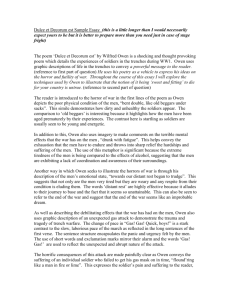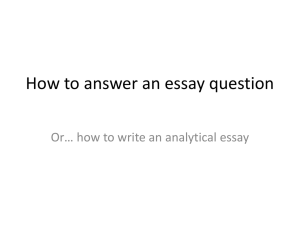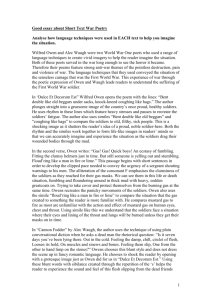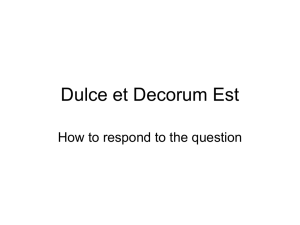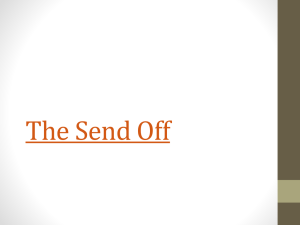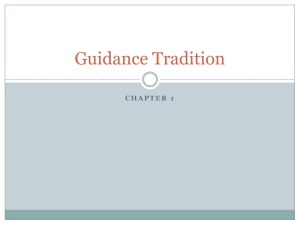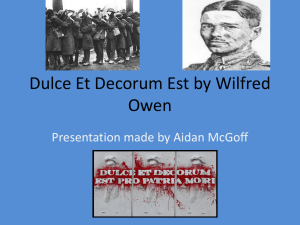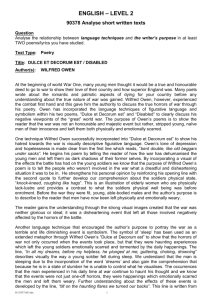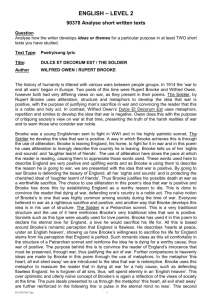Short texts eample essay
advertisement
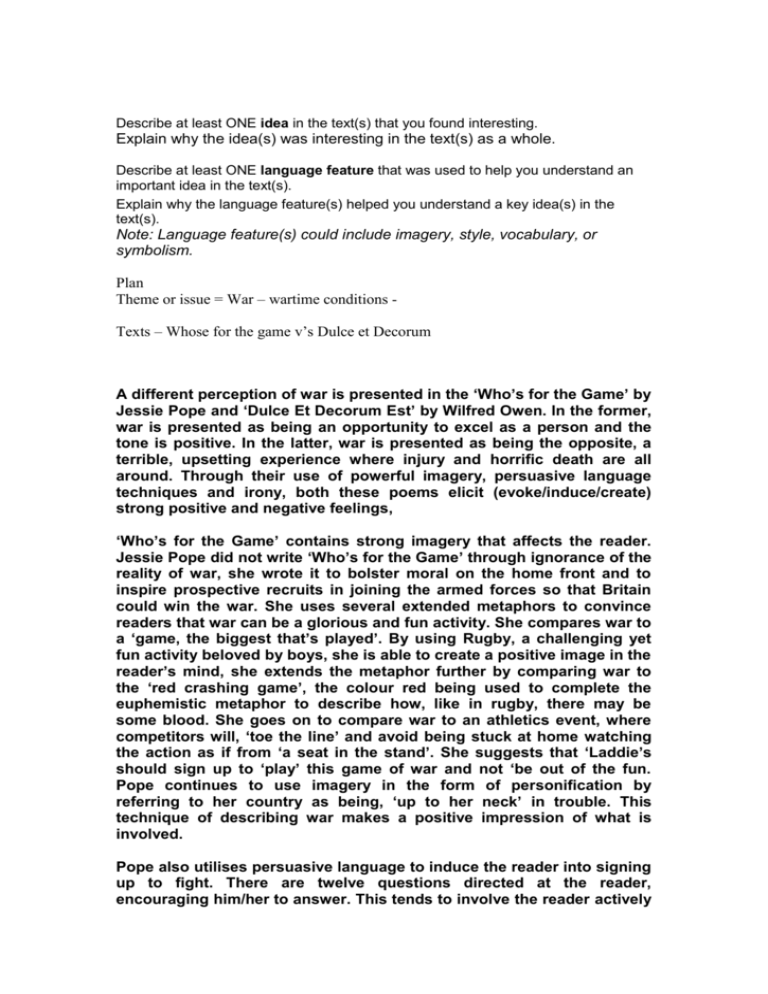
Describe at least ONE idea in the text(s) that you found interesting. Explain why the idea(s) was interesting in the text(s) as a whole. Describe at least ONE language feature that was used to help you understand an important idea in the text(s). Explain why the language feature(s) helped you understand a key idea(s) in the text(s). Note: Language feature(s) could include imagery, style, vocabulary, or symbolism. Plan Theme or issue = War – wartime conditions Texts – Whose for the game v’s Dulce et Decorum A different perception of war is presented in the ‘Who’s for the Game’ by Jessie Pope and ‘Dulce Et Decorum Est’ by Wilfred Owen. In the former, war is presented as being an opportunity to excel as a person and the tone is positive. In the latter, war is presented as being the opposite, a terrible, upsetting experience where injury and horrific death are all around. Through their use of powerful imagery, persuasive language techniques and irony, both these poems elicit (evoke/induce/create) strong positive and negative feelings, ‘Who’s for the Game’ contains strong imagery that affects the reader. Jessie Pope did not write ‘Who’s for the Game’ through ignorance of the reality of war, she wrote it to bolster moral on the home front and to inspire prospective recruits in joining the armed forces so that Britain could win the war. She uses several extended metaphors to convince readers that war can be a glorious and fun activity. She compares war to a ‘game, the biggest that’s played’. By using Rugby, a challenging yet fun activity beloved by boys, she is able to create a positive image in the reader’s mind, she extends the metaphor further by comparing war to the ‘red crashing game’, the colour red being used to complete the euphemistic metaphor to describe how, like in rugby, there may be some blood. She goes on to compare war to an athletics event, where competitors will, ‘toe the line’ and avoid being stuck at home watching the action as if from ‘a seat in the stand’. She suggests that ‘Laddie’s should sign up to ‘play’ this game of war and not ‘be out of the fun. Pope continues to use imagery in the form of personification by referring to her country as being, ‘up to her neck’ in trouble. This technique of describing war makes a positive impression of what is involved. Pope also utilises persuasive language to induce the reader into signing up to fight. There are twelve questions directed at the reader, encouraging him/her to answer. This tends to involve the reader actively in the poem; we are being spoken to directly through the use of personal pronouns in lines such as, “Who’ll earn the empire’s thanks – will you my Laddie?” and further personification of the country through, ‘she’s looking and calling for you’. It is easy to be drawn into the ideas of the poem and feel instantly patriotic and want to fight. In Wilfred Owen’s ‘Dulce Et Decorum Est’ presents a contrasting perspective of war through extreme similes and metaphors. It is noteworthy that both poets use similar techniques to achieve their aims, while Pope pressurises the reader by suggesting that they will be left out of the ‘game’, Owen uses imagery from the opposite polar. He sees the effects of war as being as ‘obscene as cancer’ and the faces of those poisoned by gas as being more contorted than a ‘devil’s sick of sin’. He presents a gruesome and highly negative vision of war through similes comparing men to ‘hags’ and ‘old beggars’. The poem is laced with references to the bad things of this world such as ‘lime’ in the eyes, ‘sores on innocent tongues’ ‘drowning’ and ‘choking’. It is ironic that Owen has used a traditional form with a regular rhyme scheme to present a negative, almost aggressive message. The title of the poem is from Horace, a Roman poet who wrote in Latin about the glory of war. Owen’s clever choice hints at a classical content of glory, honour or romanticism, but the reader finds that his meaning is the opposite. Iambic pentameter and an A/B rhyme scheme – such as ‘sludge/trudge’ or ‘stumbling/fumbling, also suggest that the poem should contain a positive message like the traditional war poems of the Nineteenth century. It is ironic that the message is the opposite, concerning the horrors of war and a pointed message to poet’s such as Jesse Pope stating that dying for one’s country is in no way glorious. Owen was confronted with horrific modes of death on a regular basis and fixates on this in this poem, critics argue, however, that soldiers can still be heroic even if their deaths are degrading/humiliating. Owen also uses personal pronouns to involve the reader in a similar fashion to Pope. He asks that if ‘you could pace’ behind the poisoned men, ‘watch’ their pain an ‘hear’ their ‘gargling’. Instead of addressing the reader as ‘Laddie’, Owen addresses the reader ironically as ‘my friend’. It is clear that Owen feels strongly about the glorified messages given to impressionable, ‘innocent’ children and is not the friend of anyone who pushes such a misleading idea. Both these poems make the reader feel strongly about war. Often, young people require little encouragement to seek glory and Pope’s techniques encourage the reader to act. In our modern world, we know the reality of war and how it can be horrific; therefore, Pope’s message may also generate a negative reaction as people are aware that war is not a ‘game’. Owen’s vision comes from the front line and is extreme in its message and impact. He strongly objects to the falsification of wartime conditions and worked hard to counter this through his poems. It is probably a good thing that contemporary WW1 society never became familiar with Owen’s work because moral and recruitment may have suffered had the public been familiar with the suffering of the front line soldiers. It is important that we keep reading and studying these poems in modern NZ to remember the horrendous sacrifice our forefathers made and to help us appreciate how fortunate and lucky we are to have been born into NZ in an era of peace and prosperity.
